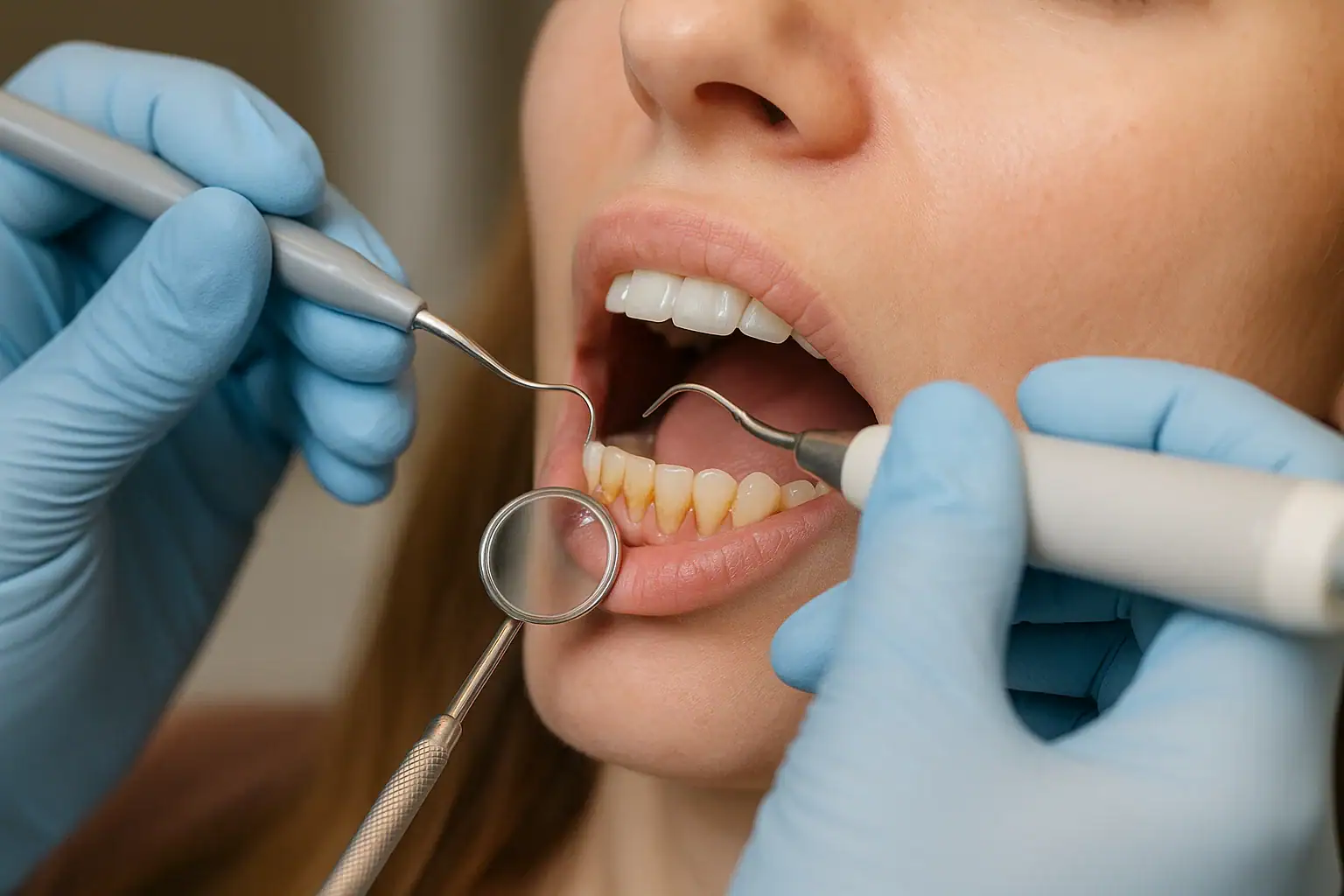Menu
Free Consultation

Dental calculus, also known as tartar, is one of the most common oral health problems in the world. Once it forms, it cannot be removed with brushing or flossing alone at home. Moreover, attending to scrape it off can damage your teeth and gums.
This article covers everything you need to know about dental calculus, including how to clean it, how to get rid of it safely, what causes it, and how you can stop it from returning.
Calculus on teeth is the result of hardened dental plaque that becomes strongly attached to the tooth surface. To understand calculus, we also need to know what dental plaque is, a soft biofilm made of bacteria, saliva proteins and food debris that forms on dental and prosthetic surfaces. While dental plaque is soft and easily removable with hygiene measures, it can calcify into calculus if not removed through brushing and flossing.
Over time, this mineralized buildup can cause the following issues:
Unfortunately, once calculus forms, only a dental professional can remove it using specialized instruments.
Several factors increase the likelihood of calculus formation, such as:
The only safe and effective method to remove calculus from teeth is through a professional dental cleaning. Dentists and hygienists use specialized tools that break calculus off without damaging enamel or soft tissue.
Scaling is the most common technique used to remove calculus by hand. During this procedure, clinicians use specialized manual scalers, curettes and other hand instruments to gently detach calculus from the tooth surfaces above and below the gumline. These fine tools allow dentists and hygienists to remove stubborn deposits and delicate areas
Ultrasonic scalers are the most commonly used method to remove calculus in modern dentistry worldwide. These devices use high-frequency vibrations and water irrigation to remove calculus efficiently, particularly heavy deposits known as calculus bridge, which is a thick, rock-hard band of calculus that covers multiple teeth.
After calculus removal, teeth are polished to smooth the enamel and slow and prevent future buildup. This final process allows your teeth and saliva to remove plaque more efficiently and provides fluoride to prevent further issues.
While you can't remove hardened calculus yourself, you can prevent new buildup by following these recommendations:
Daily toothbrushing is essential for good oral hygiene. Brush at least twice daily using a soft toothbrush and fluoride toothpaste. If you find issues managing the correct brushing technique, you can also consider using electric toothbrushes, which are equally effective at disrupting dental plaque.
No oral hygiene routine is complete without flossing. Daily interdental cleaning prevents plaque from mineralizing between teeth, where calculus forms faster and stronger. If you're having issues using dental floss, you can also consider using interdental brushes or water flossers to remove dental plaque between your teeth.
Some commercial products that contain pyrophosphate or zinc citrate reduce mineralized buildup, reducing the risk of dental calculus.
Hydration promotes healthy saliva flow, lowering plaque formation and accumulation.
You probably already know it by now, but smoking accelerates calculus formation and increases gum disease risk, among many other dental issues.
Visit your dentist every six months to keep plaque and calculus at bay. While two visits per year are more than enough to spot frequent problems in the general population, high-risk patients may need more frequent cleanings, sometimes between 3 and 4 months.
Keep in mind that consistent preventive care is the best long-term strategy to keep calculus under control.
Patients often ask or search for “how to remove calculus from teeth at home”. However, there is no home method to remove hardened dental calculus. Yes. This also includes vinegar, vegan soda, charcoal, scrapers, or flushing. None of these methods is efficient or safe to remove hardened calculus.
Moreover, DIY calculus removal can also:
Remember that safe calculus removal requires training, magnification, and sterilized instruments to prevent complications.
A calculus bridge forms when dental plaque builds up over time and solidifies, eventually unifying multiple teeth in a single, thick stone mass. This bridge often appears on the tongue side of lower front teeth, or the cheek side of upper molars.
A calculus bridge typically indicates:
Removing a calculus bridge requires careful scaling to avoid damaging weakened affected guns.
Dental cleaning is a procedure that can be performed by a dentist or hygienist after a careful evaluation to determine the extent and severity of the problem. While the exact protocol will be determined by the complexity, gum state, and general health of the patient, here are some general steps that almost every dental cleaning procedure includes:
Scaling
During this stage, your dentist or hygienist removes all visible calculus and cleans under the gumline using ultrasonic scalers or manual tools.
Irrigation
Most times, the scaling process is done with plenty of antibacterial irrigation, which may come in specialized rinses or other solutions to reduce inflammation and flush debris.
Laser and Air polishers
Learn technology allows specialists to also use other complementary measures, such as lasers and air polishing devices. In determinate frequencies, dental lasers can reduce harmful bacteria and improve general disinfection in affected soft tissues. Air polishers, on the other hand, can remove bacteria accumulation in periodontal pockets, improving periodontal disease management.
Polishing
Finally, teeth are polished with a specialized paste to smooth enamel and reduce plaque retention.
Fluoride Application
While optional, specialists can also use fluoride products, like gels, varnish or solutions, to strengthen enamel after cleaning, especially if erosion or sensitivity is present.
The cleaning process is generally comfortable and may be completed in one or multiple visits depending on the severity.
While dental calculus removal is usually a quick and painless procedure. Here are some tips to consider after your treatment:
It consists of removing plaque and calculus above the gumline for patients with healthy gums. It can also include manual or ultrasonic scaling to remove plaque and calculus slightly beneath the gumline.
This procedure is a deep-cleaning therapy that removes calculus below the gumline, specifically on the teeth’s roots, in patients with periodontal disease. Scaling and root planning typically involves local anesthesia and involves a shorter span of regular visits.
This therapy is meant for patients who have completed gum disease treatment and need ongoing cleanings every three or four months.
The appropriate cleaning for you depends on your gum health and the amount of calculus present after your initial evaluation.
Q. Can mouthwash remove calculus from teeth?
No. Mouthwash can reduce bacteria and help control plaque, but it cannot remove hardened calculus. Only professional dental tools can detach calculus from enamel and root surfaces.
Q. Does calculus always mean gum disease?
Not necessarily, but it definitely increases the risk. Early stages of gum disease, also known as gingivitis, often begin where calculus accumulates, especially along the gum line. Thus, regular cleanings prevent its progression to periodontitis.
Q. Can calculus form under the guns without me noticing?
Yes. Unfortunately, subgingival calculus forms below the gumline and it can be invisible to patients. As a result, it is often detected during dental examinations using periodontal probes and X-rays. This is the main reason why periodontal disease is often discovered in late stages, showing no initial symptoms.
Q. Are some people more prone to dental calculus?
Yes. Several factors, like saliva composition, genetics, and medication-related dry mouth, as well as other underlying health issues, can all make a person more susceptible to calculus, even with good brushing habits.
